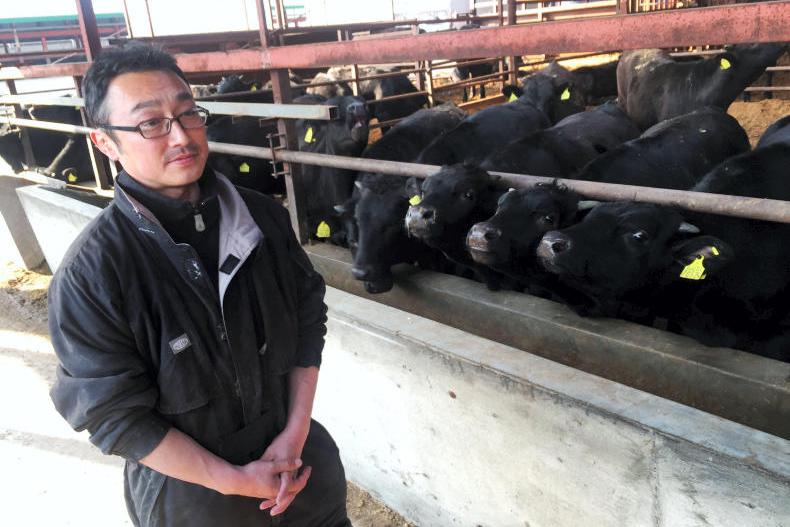On Good Friday, Ryu Takahashi sold 300 stores at the monthly mart sale – a routine he performs all year round on his 2,300-head farm in Otofuke.
 Ryu farms with his brother Daisuke and four staff as well as two part-timers.
Ryu farms with his brother Daisuke and four staff as well as two part-timers.
The Takahashi farm brings in F1 calves (pictured), which are AI-bred from Wagyu beef bulls out of Holstein dairy cows. They are sourced under one month of age through dairy producers organisations or directly from dairy farms at a cost of €2,400/head.
The Takahashi farm has invested in 13 robotic feeders to feed milk replacer to the calves, with each machine costing €17,000. Every calf has an electronic collar that dispenses the suitable feed for its needs and monitors milk intake. The farm is undertaking work with an IT consultant to make better use of this information. "Data is really important, but I want to control it, not be controlled by it," said Ryu.

After weaning, the cattle are fed rations incorporating one-third of grass and maize silage grown on the farm's 38ha. The rest is bought in, including haylage imported from North America. There is no grazing here.

When they hit eight months of age and 300kg, the cattle are sold on, at current prices of around €3,500/head.
A half-hour drive away in Memuro, Oono farm is a large-scale finishing feedlot with 4,000 cattle on 130ha. There is also a roadside cafe and some of the 16 farm workers and three office staff join the three restaurant employees during the busy lunch hours.

Such large scale is unusual in Japan, where most beef finishers operate on much smaller farms. Owner Yasuhiro Oono (pictured below) is a very progressive farmer with his finger on the pulse of innovation and consumer demand. He has just built two fermenting and flaking grain silos to produce his own feed, with half of the €700,000 cost covered by the government's generous capital grant scheme because he agreed to share the equipment with smaller local farmers. He has also signed a contract with a vet to cover two weekly visits for a fixed fee of €1,730/month.

The farm's feed has been GM-free for 15 years: "Not all consumers care about GM, but it's very important to those who do," Yahsuhiro said. He feeds 20g of yoghurt per day to each animal to reduce ammonia emissions for environmental and staff welfare benefits.  And the space between his sheds is occupied by solar panels feeding electricity to the national grid, which he said is one of the most profitable businesses on the farm.
And the space between his sheds is occupied by solar panels feeding electricity to the national grid, which he said is one of the most profitable businesses on the farm.
Calves sourced from surrounding dairy or suckler farms and marts are all brought to slaughter, with a slightly different system depending on their breed:
| Breed | Calf purchase price | Age to switch from grass-based to grain-based finishing diet | Age at slaughter | Target slaughter liveweight | Finished animal sale price |
|---|---|---|---|---|---|
| Holstein | €870 | 300 days | 20 months | 780-800kg | €4,340 |
| F1 | €2,170 | 420 days | 24 months | 850kg | €6,070 |
| Wagyu | €4,770 | 420 days | 28 months | 850kg | €10,400 |
Just like the Takahashi farm, the Oono farm uses robotic milk replacer feeders for young calves. They are kept in individual cubicles for the first month to manage health issues as they come from so many different farms.

Yahsuhiro grows 70ha of soyabean, wheat and beet to feed his herd. “After the winter wheat harvest in late July or early August, I grow oats for green manure and silage,” he said. “I harvest it around 20 October – the moisture content is high, but it is OK for silage.”
 The 60ha of grassland are used for a first cut of hay bales, a second cut of silage and sometimes a third cut. Despite this efficient system, the farm still buys in much of its feed, which accounts for 80% of costs.
The 60ha of grassland are used for a first cut of hay bales, a second cut of silage and sometimes a third cut. Despite this efficient system, the farm still buys in much of its feed, which accounts for 80% of costs.
Overall, the farm has a net margin of 3% to 5% over the sales of finished cattle. “I need 3%, 5% is good,” said Yahsuhiro.
Current factory prices in Japan range from €9/kg for Holstein cattle to €23/kg for prime Wagyu grades, with F1 cattle in the middle at €15/kg. And yes, this is carcase weight, not liveweight. In supermarkets in Tokyo, steak cuts from prime Wagyu cattle retail for €85/kg.

Read more about the Japanese beef market, the reasons for such high prices and the export potential for Irish beef in the coming weeks in the Irish Farmers Journal.
